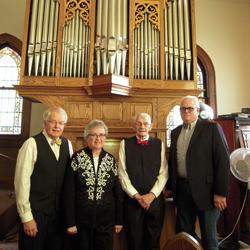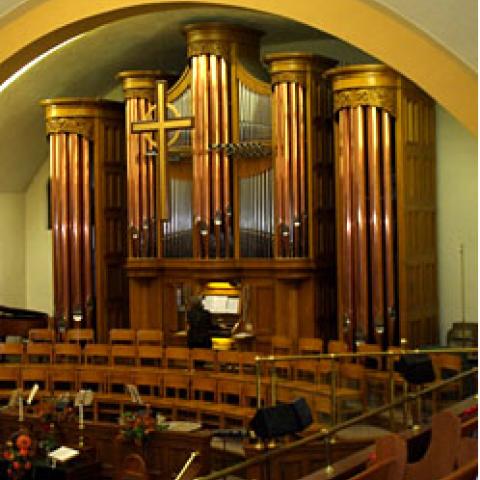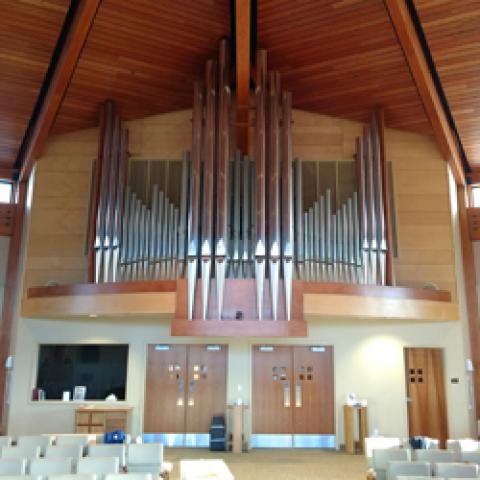Berghaus Pipe Organ Builders,
Bellwood, Illinois, was established as Berghaus Organ
Company in 1967 in Melrose Park, Illinois.
Cover photos, top: La Casa de Cristo Lutheran Church, Scottsdale, Arizona (2008); middle: O’Fallon United Church of Christ, O’Fallon, Illinois (1973); Sacred Heart School of Theology, Hales Corners, Wisconsin (1990); First United Methodist Church, South Bend, Indiana (1988); bottom: St. Benedict’s Parish, Chesapeake, Virginia (2015).
From the Founder
A native of Cleveland, Ohio, I was encouraged to leave home to seek my education at Concordia Teachers College (now Concordia University Chicago) in River Forest, Illinois. After graduation, I married and worked for several years as a parochial school teacher and church organist/choir director. My unexpected decision to enter the organ-building trade was chiefly influenced by two instruments and two men.
Before I left Ohio, Trinity Lutheran Church in Cleveland began installing a four-manual and pedal mechanical-action organ from the Beckerath company of Hamburg, Germany, which was completed in 1956. The church was near my house, and my curiosity, for some unknown reason, led me to make frequent visits during its installation and voicing. I had no earthly idea that this organ would lay the groundwork for my organbuilding philosophy!
While still enrolled at Concordia, my informal apprenticeship for organbuilding began as I started to repair the slider chests on an 1888 Jackson Organ Company (Chester, Illinois) tracker at St. Matthew Lutheran Church on the south side of Chicago. Slowly, the organ came back to life as I repaired badly damaged pipes, broken trackers, and cracked rollerboards. We found a second-hand pedalboard to replace the original and installed key extensions to accept mechanical connections to the pedal chests and couplers. By repairing an ancient blower and wind system, a somewhat compromised new life to the organ was born. By 1961 the organ was again used for services. Subsequently, the congregation authorized Berghaus Organ Company to extensively rebuild the organ with new slider chests, pipework, action, and wind system. Since 1972 the organ remains as rebuilt.
Why devote time to these two churches and their organs? These were my mind and eye openers! I had a gnawing curiosity to tear into the old Jackson organ, find out what went wrong, and fix it! In the Beckerath, I had a “new” organ for comparison.
Sometime in 1967 while a fifth and sixth grade teacher, I was approached by John F. Shawhan, the Midwest service and sales representative of Casavant Frères of Canada, to take over a dozen or so contracts to provide semiannual service and maintenance for new Casavants located from Des Moines to Fort Wayne. I still had no plans on becoming an organbuilder, but November 1967 was my final month as a teacher. John paired me up with his assistant, Paul Jochum, who spent time in the Beckerath shop as a general apprentice. When I first met Paul, I assumed that I would be the tuner and he would be the key holder. But that is not how he had it planned! He insisted that he tune and I sit at the console. And that was the arrangement for all the years we worked together. His disciplined tuning was impeccable and went so far as to check the tuning of higher-pitched mixtures by listening through the entire stop without the tuning stop on!
As the service and tuning business grew, the opportunity came along to build an instrument. The O’Fallon United Church of Christ in southern Illinois was planning an extensive renovation of its church. The original Kilgen tracker was entombed behind the altar and was in serious need of repair. Casavant turned down the project and asked Berghaus to consider it. I, too, turned down the opportunity to renovate the old Kilgen.
They asked, “Who do you recommend to do the renovation?” I said that I would build a new mechanical-action organ for them instead. What did I have to show? Nothing! But they chose Berghaus despite our lack of experience. The contract was signed and construction took place in a 24′ by 27′ garage with an extremely limited number of tools and space. Today, this organ stands as built in 1973. A few years ago, we thoroughly cleaned it and set it back on course for another 40-plus years of faithful service.
After O’Fallon, four contracts were negotiated in fairly rapid succession for 2-manual and pedal mechanical-action organs. As these were being built, a noticeable change in design requests followed: namely, to retain the mechanical key action, but to abandon the mechanical stop action and utilize a more user-friendly stop control system. This was an acceptable alternative to me, as it did not affect the key action or the windchest design. I was firmly convinced that slider windchests were the best chests in the world! The most striking change came with the detached, moveable console, requiring the separation of the direct key action from the windchests, which we accommodated by installing electric pull-down magnets outside the pallet box.
Our stay in a house basement and two-car garage lasted a very short time. By 1973 we moved to Bellwood into a facility of approximately 4,000 square feet and a ceiling height of only 13 feet. A number of organs exceeding that height were built in this low-ceiling room. In 1984, a two-story erecting room and design and fabrication spaces were added to facilitate construction of larger instruments.
Time passed so fast that it became unnoticeable. My wife, Judy, worked many years as the office manager. Both of our sons, Todd and Brian, served us well in service projects, organ construction, and installations. It would be Brian whom I would entrust with continuing my work by taking the leadership of the company into the second generation. Along the way, he would build a team around him.
—Leonard G. Berghaus
From the Tonal Director
When I joined Berghaus in 2006, the company was in a period of transition. While the hallmarks of slider chests, open-toe voicing, and Werkprinzip were still present in many instruments, a few others were examples of a more eclectic approach to tonal design. The 2003 four-manual instrument created for St. Stephen’s Episcopal Church in Wilkes-Barre, Pennsylvania, combined new resources with many ranks from the Aeolian-Skinner organ built in the 1950s. The result was decidedly more American Classic in sound, and it has enjoyed great success in live performance as well as several recordings. Subsequent years saw the installation of more eclectic organs at St. John’s Lutheran Church, Bloomington, Illinois (3 manuals, 46 ranks), and Queen of All Saints Basilica, Chicago, Illinois (3 manuals, 60 ranks).
My own background in pipe organs began at the age of 13, when I first took organ lessons and began playing church services some months later. I had always been fascinated with the pipe organ; I used to spend many hours listening to recordings of instruments from all over the world, conjuring up stoplists, and occasionally attempting to design casework and façades. Little did I know then that this would ultimately become my career! I completed organ studies at Valparaiso University and The Juilliard School; these institutions educated me with a solid foundation of organ performance in both concert and church settings. My many opportunities to perform around the country allowed me first-hand experience with the great wealth of pipe organs in this nation, and I began to formulate my thoughts of what my own personal tonal signature would be.
In 2007, the Berghaus-built organ for St. John’s Episcopal Church, Chevy Chase, Maryland, would be my first opportunity to make my mark. With a stoplist that leans more into the French Romantic realm (complete with a sumptuous Cavaillé-Coll-style drawknob console), this instrument of 3 manuals and 63 ranks began a new era for our company. The organ, both in its stoplist and tonal approach, is a synthesis of classical and romantic styles. As a result, it emphasizes a clear and singing sound in the individual stops, while at the same time providing warmth and depth when stops are used in combination. Each division contains a complete principal chorus, characteristic flute stops, and reeds both fiery and more subdued. Decidedly different from previous instruments is the treatment of string and reed tone. The Grand-Orgue and Récit contain Salicionals with more harmonic prominence, which aid in carrying accompaniment lines found in homophonic music. While our past instruments accentuated the build-up of the Tutti through upperwork and mixtures, this organ places reed tone in the several Trompette and Bombarde ranks at the fore, paying homage to the symphonic style.
These principles were also carried out in the instruments of 2007–08: St. Jerome Catholic Church in Oconomowoc, Wisconsin (3 manuals, 53 ranks), built in collaboration with Scott R. Riedel & Associates as the organ consultant/acoustician, and First Lutheran Church, Manitowoc, Wisconsin (3 manuals, 41 ranks).
2008 brought an extraordinary opportunity to construct our magnum opus for La Casa de Cristo Lutheran Church in Scottsdale, Arizona. Taking cues from the American Classic and Romantic traditions, our tonal approach was to design an eclectic instrument that would handle a wide range of repertoire, capable of a vast amount of both dynamic and tonal expression. To that end, there are no less than five manual 8′ Principals, ten different 8′ and 4′ flutes, and strings and hybrid (tapered) stops, which are of varying tone and construction. The versatility of this instrument is the result of our ability to finish every stop as its own beautifully unique voice and also as a worthy contributor in combination.
Given the challenge of designing a 92-rank organ with only one division under expression, it became clear from the beginning that great care would need to be taken in the tonal finishing process to ensure the success of a seamless crescendo and equally balanced manual divisions. The ranks of the Positiv division are designed and voiced so as to provide a remarkable degree of expressiveness for an unenclosed division. The overall effect in the crescendo is that of a continuous transition from ppp to fff without any staggering dynamic or color steps.
In recent years, because of economic challenges, many churches have elected not to build entirely new instruments, but to retain as much as they could from their current organ or investigate viable options of transplanting a vintage instrument. One of our unique endeavors was creating an instrument for First Presbyterian Church, Johnson City, Tennessee, by combining resources from two organs in need of a new home: a 1930 Casavant from Our Lady of Grace, Chicago, and the Berghaus from Christ Lutheran Church, Cleveland, Ohio. On paper, these two disparate tonal concepts would not necessarily work well by merely placing stops together. To achieve good blend within and among the divisions, and to provide appropriate combinations for musical performance, we decided to keep the Great and Swell divisions of the Berghaus together, but reassign them and enhance the 8′ tone to be adequately scaled for the new space. The new Great and Pedal divisions would combine new pipework and vintage stops that were fully restored or changed to blend with the overall tonal concept. We have also successfully installed instruments of this type with the help of consultant Wayne Wagner at Zion Lutheran Church, Columbus, Wisconsin (2 manuals, 24 ranks) and in partnership with Edward Meyer at Luther Preparatory School, Watertown, Wisconsin (2 manuals, 35 ranks).
2014 brought us an opportunity to work with organist and historical author Peggy Kelley Reinburg, who acted as consultant for St. Benedict’s Parish, Chesapeake, Virginia. Her insight into pipe organs and tonal design proved to be an invaluable resource. Together with her, we collaborated to present an instrument with a heart of simplicity and clarity, rooted in North German tradition but also possessing a distinctive voice. This instrument brings our company full circle to its early beginnings—confident in the creation of instruments in a classic style, while tailoring tonal schemes that serve the specific needs of our many different clients.
As Berghaus celebrates 50 years, we can applaud the first instruments of our founder, Leonard Berghaus, and his many successful contributions to organbuilding. Each instrument that has been produced since I started in 2006 is unique in its own right, and I am truly proud of them all. I look forward to what the next years will bring, both in challenges and opportunities.
—Jonathan Oblander
From the President
My apprenticeship at Berghaus began at a very young age. I have fond memories of being pulled out of class at Grace Lutheran School to help assist with organ repairs, or so they thought! Little did I know that this would set the stage for my life’s work. My high school summers were spent working for Berghaus in a variety of roles, and in 1988 I began my full-time position. My training and work experience was primarily in casework, structure, winding, and windchest construction. As time went on, I gradually moved into project management for several years before being appointed vice president in 1999. In 2004, I was named president of the firm.
During the mid-1990s, I began to look to the future of the company and realized that to grow and remain viable, we would have to employ a new business model of separating the new organs from the service side and executing multiple projects at once. A larger facility would be needed to accommodate the change. In 1999, after several years of exploring various options, including construction of a new facility, we located a building. Although it had been vacant for a number of years, the advantages far outweighed the drawbacks. Its location less than a mile from our previous facility meant that the remodeling process and relocation would have a minimum impact on our production schedule and the more than 200 clients for whom the company provided service and maintenance.
The move in 2001 from a 6,700-square-foot building to a 30,000-square-foot plant afforded Berghaus the opportunity to design a more streamlined approach to our processes. A new set-up room with a ceiling height of 38 feet was constructed to accommodate larger instruments. The remodeled service area allowed for a clean and spacious environment to accomplish all aspects of organ service and maintenance. One of the depressed loading docks was filled in to create additional 26′ by 52′ space for managing multiple projects simultaneously. Four separate voicing rooms were created to allow our artisans to excel in their craft. A conference room and spacious office area completed the updated state-of-the-art facility. The building underwent other significant structural updates and improvements, including a new fire/burglar alarm system and surveillance for safety and the protection of our clients’ property.
In addition, the new facility allowed us to install more efficient and larger equipment to the plant floor. A new spray booth, dust collection system, 54-inch-wide belt sander, and multiple TigerStopsTM significantly updated our production process. With four new vacuum press tables, we were able to press up to eight slider chests in one day, something that would have taken us four days to accomplish in the past. Recent additions to our technology include a 3-D printer and planning for the installation of a large CNC machine.
With my father nearing retirement, there was no doubt in my mind that a different business model would be needed to propel the company forward and continue our commitment to excellence. His were big shoes to fill. It is sobering and gratifying when I think of the many former Berghaus employees who were mentored by my father and have prominent positions throughout the industry. Preserving his legacy and continuing his life’s work was a daunting task. To accomplish this, I created a new team approach made up of a variety of artisans with the same dedication to the art of organbuilding that my father instilled in me. The new methodology produced a positive, collaborative working environment and a superior instrument, resulting in a secure future for all.
Berghaus has a history of successfully building both mechanical action and electric slider chest instruments and has continually made improvements to its approach. At the turn of the century, the advances started accelerating as the new Berghaus team began incorporating wooden windlines, 1.75-inch tongue and groove solid hardwood enclosures, European racking, and fastidious wire management into the construction techniques. Today, three-dimensional modeling and design create a realistic representation for new instrument presentation drawings and aid in the efficiency of in-shop construction. The case and console designs are an organic part of the rooms in which they reside. Our tonal finishing is, quite simply, second to none. Along with the aforementioned construction changes, we have an overhauled marketing approach with a new corporate image, website, and brochure.
What did not change was our commitment to maintaining high standards for every task our clients hire us to do, from tuning and service to building new instruments. We take great pride in tuning throughout the Midwest and beyond. From emergency service seven days a week to releathering reservoirs or cleaning instruments, our service business is paramount to our success and we appreciate the trust our clients have in us.
Our company is still devoted to the time-honored tradition of slider chests, low to moderate wind pressures, and pure and natural voicing practices. Our later instruments retain these hallmarks while presenting new colors and possibilities for performance of many schools of organ composition. Celebrating our 50th anniversary gives me the opportunity to reflect on the past and contemplate the honor of leading Berghaus into the future. The tremendous pride and respect I have for my staff and their accomplishments cannot be expressed in words.
—Brian D. Berghaus
Please mark your calendars to celebrate the Berghaus 50th Anniversary with a recital at Grace Lutheran Church, River Forest, Illinois, November 12, 4:00 p.m. A reception will follow in the fellowship hall.





